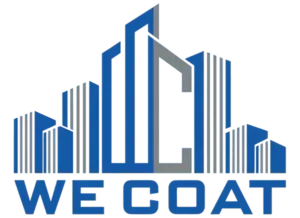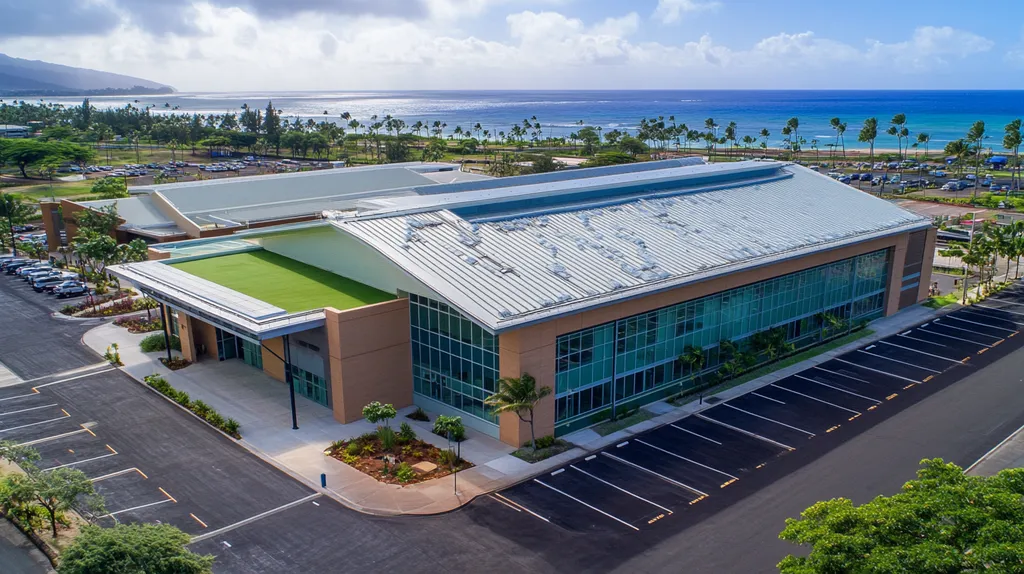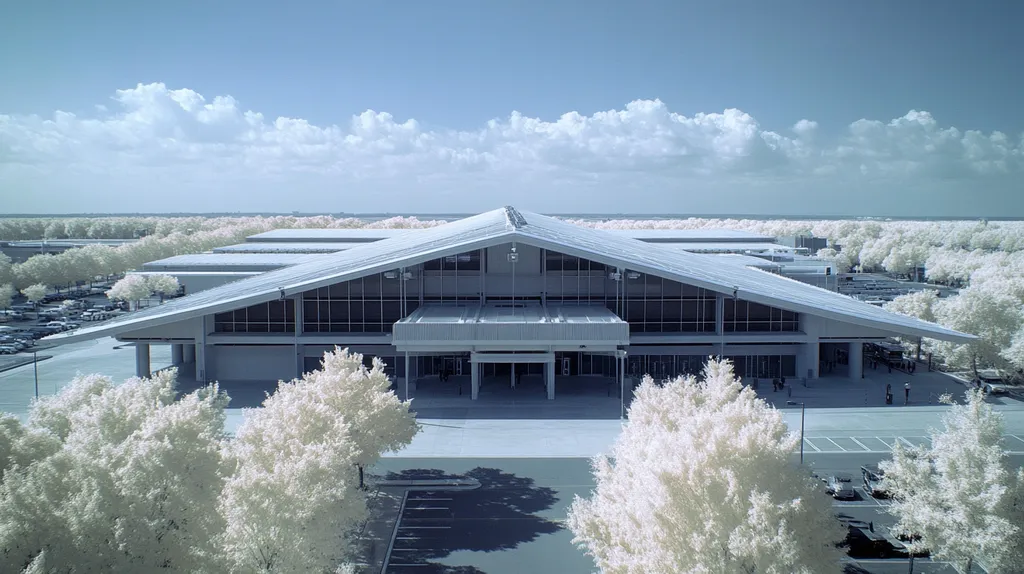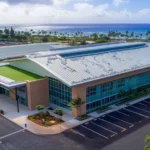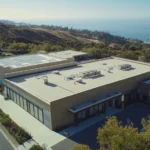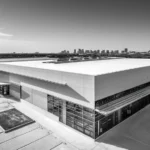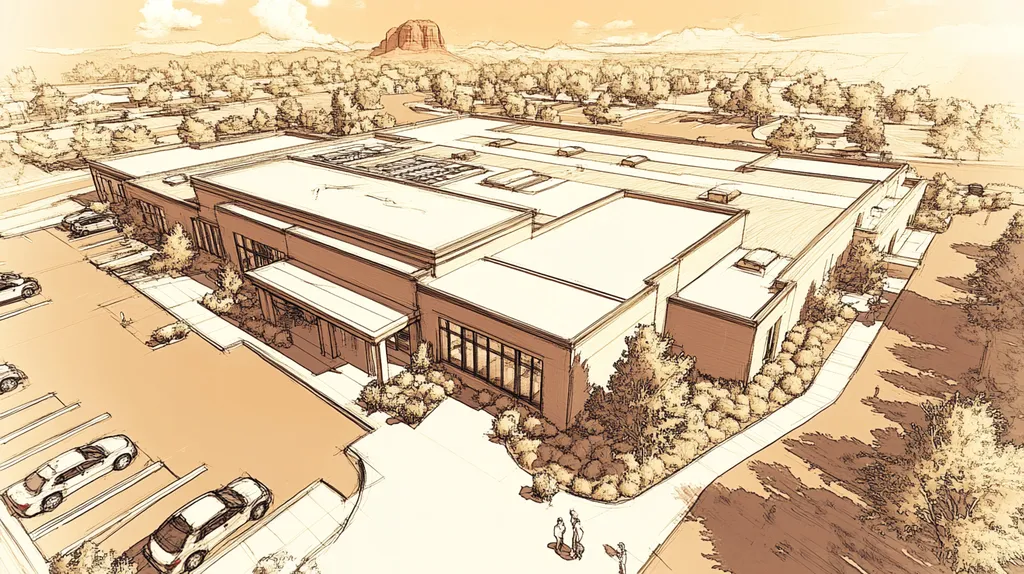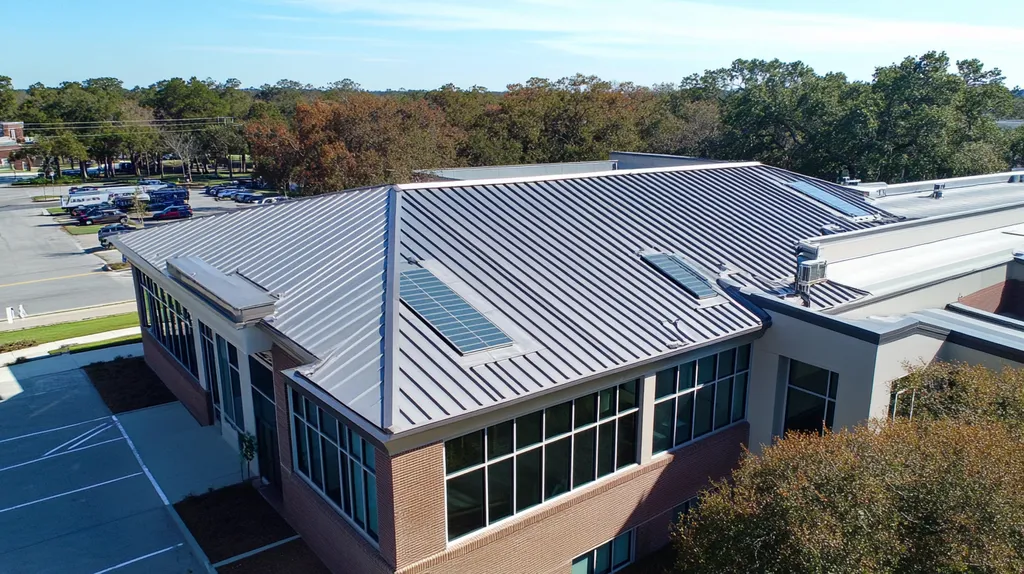Commercial roof coating failures cost property owners over $1.2 billion annually in premature replacements and repairs, with 75% of these failures stemming from improper reference selection and application guidance.
As building operational costs continue rising and environmental regulations become stricter, selecting and implementing the right coating system becomes increasingly critical for long-term facility protection.
This comprehensive handbook provides facility managers and property owners with authoritative, actionable guidance on commercial roof coating standards, specifications, and best practices – from fundamental concepts through advanced optimization strategies.
SECTION 1: FUNDAMENTAL CONCEPTS
Commercial roof coatings represent a critical investment for property owners, with the potential to extend roof life by 10-15 years and reduce cooling costs by up to 30%. As building operational costs continue to rise and sustainability regulations become stricter, selecting the appropriate coating system becomes increasingly vital. Understanding the fundamentals of roof coatings – from material types to compatibility requirements – can mean the difference between a successful application and a costly failure.
Types of Commercial Roof Coatings
Modern roof coating technology has evolved significantly to meet diverse commercial needs. The ASTM D6083 standard for acrylic coatings now recognizes two distinct performance categories: Type-I for extreme cold flexibility and Type-II for moderate climate applications. (source: BASF Insights)
Silicone coatings excel in moisture resistance and UV stability, making them ideal for regions with high rainfall or intense sun exposure. These coatings maintain their flexibility and weathering properties even after decades of service.
Polyurethane coatings come in aromatic and aliphatic varieties. Aromatic formulations provide excellent base protection, while aliphatic top coats deliver superior color retention and abrasion resistance.
Emerging coating technologies include hybrid systems that combine multiple chemistries for enhanced performance. These innovations offer improved adhesion, longer service life, and better resistance to environmental stressors.
Benefits and Limitations of Coatings
The primary advantage of roof coatings lies in their ability to extend existing roof life without requiring complete replacement. This approach can reduce installation costs by 50-70% compared to full roof replacement.
Energy savings represent another significant benefit, particularly with reflective coatings. These systems can reduce roof surface temperatures by up to 60°F during peak summer conditions, leading to substantial cooling cost reductions.
However, coatings do have limitations. They cannot resolve structural roof issues or replace severely damaged membranes. Performance also varies significantly based on application conditions and substrate preparation.
Weather conditions during application can impact coating effectiveness. Most systems require specific temperature and humidity ranges for proper curing and adhesion development.
Compatibility with Roofing Materials
Substrate compatibility determines coating success or failure. Each roofing material – whether metal, modified bitumen, single-ply, or built-up roofing – requires specific coating formulations and preparation methods.
Surface preparation dramatically influences coating adhesion. Even the most advanced coating will fail if applied to a dirty, wet, or deteriorated surface. Professional cleaning and repairs must precede any coating application.
Chemical compatibility between existing roofing materials and new coatings is crucial. Some combinations can result in material degradation or adhesion failure. Testing patches in inconspicuous areas helps verify compatibility.
Environmental factors also affect compatibility choices. Facilities in coastal regions need different coating specifications than those in arid climates due to varying exposure conditions and chemical resistance requirements.
SECTION 2: SYSTEM COMPONENTS
The success or failure of a commercial roof coating system often hinges on selecting and properly implementing the right combination of materials. With coating failures costing businesses millions annually in repairs and replacements, understanding these critical components is no longer optional. Modern coating systems have evolved into sophisticated solutions that can extend roof life by decades – but only when the right components are selected and properly integrated.
Acrylic, Polyurethane, and Silicone Coatings
Acrylic coatings dominate the market due to their excellent balance of performance and cost. These water-based solutions provide outstanding UV protection while remaining environmentally friendly and easy to apply in most weather conditions.
Polyurethane coatings create an exceptionally durable protective layer that resists chemical exposure and physical abuse. Available in both aromatic (base) and aliphatic (top coat) formulations, these coatings excel in high-traffic areas and industrial environments.
Silicone coatings stand out for their superior weathering characteristics and moisture resistance. They maintain flexibility even after decades of UV exposure, making them ideal for buildings in extreme climates.
Each coating type offers unique advantages that should align with specific project requirements. For example, acrylics work best in moderate climates, while silicones excel in areas with frequent rainfall or intense sun exposure.
PMMA and Other Specialized Coatings
Polymethyl methacrylate (PMMA) coatings represent the cutting edge of roofing technology. These advanced systems cure rapidly and can be applied in a wider range of temperatures than traditional coatings.
Specialized reflective coatings incorporate ceramic microspheres or advanced pigments to maximize solar reflection. These innovative materials can reduce roof surface temperatures by up to 80°F during peak summer conditions.
Hybrid coatings combine multiple technologies to overcome traditional limitations. These systems often incorporate the durability of polyurethane with the UV resistance of acrylics or the moisture resistance of silicone.
The evolution of coating technology continues to produce more effective solutions. New standards now recognize distinct performance categories that better match modern application needs and environmental challenges.
Auxiliary Materials and Reinforcements
Reinforcement fabrics play a crucial role in strengthening coating systems at critical points. These materials, typically polyester or fiberglass, provide additional tensile strength and help bridge small cracks or gaps in the substrate.
Primers serve as the crucial link between the substrate and coating system. Different roof surfaces require specific primer formulations to ensure proper adhesion and prevent premature coating failure.
Sealants and mastics complete the system by addressing penetrations, seams, and other challenging areas. These materials must remain flexible while maintaining watertight integrity throughout the coating’s service life.
Surface preparation materials, including cleaners and etching solutions, ensure proper coating adhesion. Even the most advanced coating will fail without appropriate surface preparation and auxiliary material selection.
SECTION 3: IMPLEMENTATION METHODS
The success of a commercial roof coating project hinges on meticulous implementation. Studies show that over 80% of coating failures stem from improper application rather than product defects. As commercial buildings face increasing pressure to maintain energy efficiency and extend roof lifespans, proper coating implementation has become more critical than ever. Understanding and following proven methods can mean the difference between a coating that lasts 15+ years and one that fails prematurely.
Pre-Application Preparation and Testing
Thorough substrate evaluation marks the first critical step in coating implementation. This includes core sampling to check for trapped moisture, infrared scanning to identify wet insulation, and adhesion testing to verify coating compatibility.
Surface preparation requires removing all contamination that could compromise coating adhesion. This includes power washing, scraping loose materials, and treating rust or corrosion on metal surfaces.
Proper repairs must address all existing roof defects before coating begins. This includes sealing gaps, reinforcing seams, and replacing damaged sections of the roofing membrane.
Environmental conditions significantly impact coating success. Temperature, humidity, and dew point must fall within manufacturer specifications, typically requiring monitoring for 24-48 hours before application.
Application Techniques and Best Practices
Roof coatings come in different formulas, each requiring specific application methods based on the roofing system and climate conditions. Acrylic coatings excel on flat roofs in moderate climates, while silicone performs better in wet conditions with ponding water. (source: The Roof Co.)
Application thickness must meet manufacturer specifications, typically measured using wet film thickness gauges. Uniform coverage ensures optimal performance and prevents premature wear in thinner areas.
Multiple coat applications require proper timing between layers. Rushing this process can trap solvents or moisture, leading to blistering and delamination.
Detail work around penetrations, flashings, and edges demands extra attention. These areas often require reinforcement fabric and additional coating layers to ensure watertight protection.
Safety Considerations and Regulations
OSHA compliance requires comprehensive fall protection systems when working at heights. This includes proper guardrails, warning lines, and personal fall arrest systems for all workers.
Ventilation becomes crucial when applying solvent-based coatings. Proper air movement helps protect workers from harmful fumes and ensures proper coating cure rates.
Personal protective equipment requirements vary by coating type. Workers need respiratory protection for spray applications, chemical-resistant gloves for all applications, and eye protection throughout the process.
Emergency response protocols must address potential chemical spills, worker injuries, and weather-related risks. Having these procedures in place before work begins prevents costly delays and ensures worker safety.
SECTION 4: MAINTENANCE REQUIREMENTS
Commercial roof coating maintenance represents a critical yet often overlooked aspect of building management. Studies indicate that proper maintenance can double a coating’s lifespan, while neglect leads to premature failure and costly repairs. With replacement costs averaging $8-12 per square foot, maintaining coating integrity becomes essential for protecting this significant investment. Understanding and implementing proper maintenance protocols helps facility managers maximize both performance and longevity.
Routine Inspection and Evaluation
Professional roof inspections should occur biannually – typically in spring after winter weather stress and fall before cold weather sets in. These evaluations must cover coating adhesion, surface deterioration, and drainage patterns.
Key inspection points include seams, flashings, and areas around rooftop equipment where coating wear occurs most rapidly. Documenting these vulnerable areas with photos and detailed notes creates a valuable baseline for tracking deterioration rates.
Moisture scanning using infrared technology can detect subsurface water infiltration before visible damage appears. This early detection capability proves especially valuable for maintaining warranty coverage and preventing extensive repairs.
Building maintenance staff should conduct monthly visual checks between professional inspections. These brief surveys can identify emerging issues like ponding water or coating blisters that require prompt attention.
Repairing and Reapplying Coatings
Minor coating damage requires immediate attention to prevent water infiltration and substrate deterioration. Repairs must use materials compatible with the existing coating system to ensure proper adhesion and performance.
Surface preparation remains critical for repair success. All damaged areas need thorough cleaning and proper drying before applying new coating materials. Rushing this process often leads to adhesion failures.
Recoating typically becomes necessary every 7-10 years depending on environmental exposure and wear patterns. This process requires careful evaluation of the existing coating to determine whether removal is needed before reapplication.
Weather conditions significantly impact repair and recoating success. Most coating materials require specific temperature and humidity ranges for proper curing, making scheduling and monitoring essential.
Preventative Maintenance Strategies
Regular cleaning prevents debris accumulation that can trap moisture against the coating surface. Quarterly removal of leaves, branches, and other debris helps maintain proper drainage and coating performance.
Establishing designated roof access paths with walkway pads protects coating from foot traffic damage. This simple measure significantly reduces wear in high-traffic areas around equipment and access points.
Chemical exposure from HVAC condensate or exhaust requires monitoring and potentially additional protective measures. Installing condensate collection systems or redirecting exhaust can prevent premature coating deterioration.
Documentation of all maintenance activities, including cleaning, repairs, and inspections, helps track coating performance over time. This data proves invaluable for planning future maintenance and budgeting for eventual recoating needs.
SECTION 5: PERFORMANCE METRICS
Commercial roof coating performance directly impacts building operational costs, energy efficiency, and long-term asset protection. With energy costs averaging $2-3 per square foot annually for commercial buildings, the right coating system can reduce these expenses by 20-35%. Understanding and measuring key performance metrics helps facility managers make data-driven decisions about coating selection and maintenance timing.
Energy Efficiency and Cost Savings
Modern roof coatings can dramatically reduce building cooling loads through enhanced solar reflectivity. Cool roof coatings can lower peak roof temperatures by 50-60°F compared to traditional dark surfaces, directly impacting HVAC energy consumption.
Initial coating costs typically return 3-5 times their value through reduced energy bills over the system’s lifespan. This calculation becomes even more favorable when factoring in available utility rebates and tax incentives for energy-efficient roof solutions.
Building envelope efficiency relies heavily on coating performance metrics like solar reflectance index (SRI) and thermal emittance. Higher SRI values indicate better heat reflection, while emittance measures how effectively the surface releases absorbed heat.
Regular monitoring of energy consumption patterns before and after coating application helps validate performance. Smart building systems can track these metrics automatically, providing valuable data for future coating decisions.
Durability and Lifespan Evaluation
Coating durability directly affects maintenance costs and replacement cycles. Key performance indicators include adhesion strength, elongation capacity, and tensile strength – all of which should be tested regularly throughout the coating’s service life.
Environmental exposure testing helps predict coating longevity under specific conditions. Accelerated weathering chambers can simulate years of UV exposure and temperature cycling in just weeks, providing crucial performance data.
Impact resistance becomes especially important in areas prone to hail or frequent maintenance traffic. Quality coatings should maintain their protective properties even after repeated physical stress.
Chemical resistance proves critical near HVAC equipment or in industrial areas where airborne pollutants can degrade coating performance. Regular testing ensures continued protection against these environmental challenges.
Weather Resistance and UV Protection
Weather resistance metrics focus on coating performance under extreme conditions. Critical measures include water absorption rates, permeability ratings, and resistance to thermal shock from sudden temperature changes.
UV stability determines how well coatings maintain their protective and reflective properties over time. High-quality systems should show minimal degradation even after years of sun exposure, maintaining their energy-saving benefits.
Wind uplift resistance becomes increasingly important as extreme weather events become more common. Proper adhesion and coating flexibility help prevent damage during high-wind conditions.
Ponding water resistance separates premium coatings from basic options. Superior formulations maintain their integrity even after extended water exposure, preventing the deterioration that often leads to leaks and membrane damage.
SECTION 6: OPTIMIZATION STRATEGIES
Optimizing commercial roof coating systems has become critical as buildings face increasing environmental pressures and rising operational costs. Studies show that poorly optimized coating systems fail up to 3 times faster than properly specified solutions, leading to millions in unnecessary repairs and replacements. With energy costs continuing to climb and extreme weather events becoming more frequent, implementing proven optimization strategies has never been more important for protecting commercial roofing investments.
Climate-Specific Coating Selection
Local climate conditions should drive coating selection, as environmental stressors directly impact system longevity. Buildings in hot, sunny regions need coatings with superior UV resistance and solar reflectivity, while facilities in coastal areas require enhanced protection against salt spray and moisture.
Temperature fluctuations pose a particular challenge, as coatings must maintain flexibility through freeze-thaw cycles. High-quality elastomeric formulations can expand and contract without cracking, while rigid coatings often fail under thermal stress.
Rainfall patterns influence moisture resistance requirements. Areas with frequent precipitation need coatings that resist ponding water and maintain watertight integrity even under prolonged exposure.
Wind exposure affects both coating durability and application methods. Buildings in high-wind zones require systems with superior adhesion and may need additional reinforcement at edges and corners.
Budgeting and Cost-Benefit Analysis
Initial coating costs typically represent only 20% of total lifecycle expenses. Smart budgeting considers long-term factors like maintenance requirements, energy savings, and expected service life to determine true value.
Energy efficiency improvements can offset coating costs within 3-5 years through reduced cooling expenses. Reflective coatings often reduce peak roof temperatures by 50-60°F, dramatically lowering HVAC loads.
Maintenance costs vary significantly between coating types. While premium systems cost more upfront, they often require less frequent repairs and recoating, reducing long-term expenses.
Warranty coverage should factor into budgeting decisions. Extended warranties may cost more initially but provide valuable protection against premature failure and unexpected repair costs.
Integrating Coatings with Other Roofing Systems
Successful coating integration requires understanding how different roofing components interact. Insulation layers, drainage systems, and penetrations all influence coating performance and must be considered during system design.
Flashings and terminations need special attention during coating application. These critical areas often require reinforcement fabric and additional coating layers to ensure watertight protection.
Equipment mounting systems and roof accessories must work seamlessly with coating systems. Proper integration prevents damage from thermal movement and ensures continuous protection around penetrations.
Future roof modifications should be considered when selecting coating systems. Choosing coatings that can accommodate new equipment installations or repairs helps maintain long-term roof integrity.
The Bottom Line
With commercial roof coating failures costing property owners over $1.2 billion annually, implementing proper reference standards and specifications has never been more critical.
The growing complexity of coating systems, combined with stricter environmental regulations and rising energy costs, demands a comprehensive understanding of selection criteria, application methods, and maintenance protocols.
By following industry-validated references for coating selection, preparation, and implementation, facility managers can extend roof life by 10-15 years while reducing cooling costs by up to 30%.
As building technology continues advancing, staying current with coating standards and specifications will remain essential for protecting commercial roofing investments and optimizing facility performance.
The future of commercial roofing depends on properly leveraging these critical reference materials to ensure long-term success.
FREQUENTLY ASKED QUESTIONS
Q. What are commercial roof coatings and why are they important?
A. Commercial roof coatings are protective layers that enhance roof longevity by up to 15 years. They reduce cooling costs significantly, making them a smart investment for building owners, especially as operational expenses rise.
Q. Which coatings should I choose for my commercial roof?
A. The right choice depends on your building’s specific needs. Acrylic coatings work well in moderate climates, while silicone coatings offer superior moisture resistance, making them ideal for rainy areas.
Q. How can I ensure the successful application of my industrial roof coating?
A. Success hinges on thorough surface preparation and following application guidelines. Regular checks of environmental conditions, like temperature and humidity, can ensure optimal conditions for bonding and durability.
Q. How often should I inspect my commercial roof coating?
A. It’s best to inspect your roof biannually, typically in spring and fall. Monthly visual checks can also help catch early signs of wear, allowing for timely maintenance and preventing costly repairs.
Q. What performance metrics should I track for my roof coatings?
A. Key metrics include energy efficiency, durability, and weather resistance. Monitoring energy consumption patterns and assessing coating adhesion can provide valuable insights for future maintenance and improvements.
Q. How can I optimize my commercial roof coating system?
A. Optimize your system by selecting coatings tailored to your climate, considering long-term costs, and ensuring proper integration with existing roofing components. This prevents quick failures and maximizes performance.
Q. When should I consider recoating my commercial roof?
A. Recoating typically becomes necessary every 7-10 years, depending on environmental exposure. Evaluating your existing coating’s condition and wear patterns can help determine the right timing for recoating.
